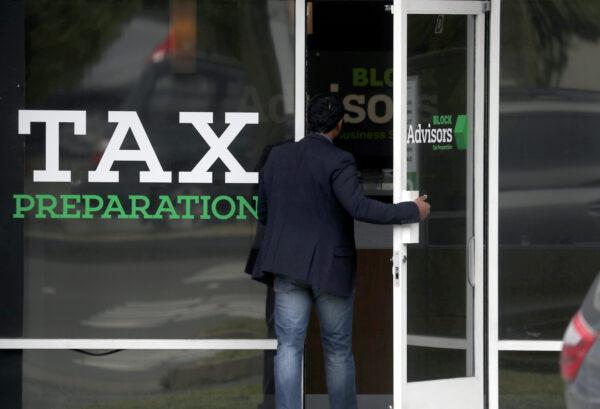Arriving nearly a year past its due date, an annual financial report from the California State Controller’s Office released March 15 details more than $255 billion in unfunded liabilities.
Such represents a record for the state and is the highest amount in the nation.
The report, known as the Annual Comprehensive Financial Report, covering the fiscal year ending June 30, 2022, attributes much of the shortfall to promises made to state workers and retirees.
“It shows you how deep in the hole you are,” former state Sen. John Moorlach, also a certified public accountant, told The Epoch Times. “It’s just like a thermometer to tell you where we’re at.”
Pension debt and other employee-related benefits account for more than $150 billion, about 60.4 percent, of the liabilities, and another $64.6 billion is related to outstanding bond debt from past projects building schools and acquiring other capital assets, according to the report.
Money owed to fund pensions increased significantly beginning with the passage of Senate Bill 400 in 1999, according to experts. The measure changed the formula to calculate retirement benefits which increased payments for many workers.
The largest pension plans have remained underfunded in recent decades, including the California Public Employee Retirement System—with only about 71 percent of liabilities funded, according to the system’s website.
Such could have been avoided if the state had not changed the retirement formula and had purchased bonds at the market rate of 8 percent in 1999 instead of investing in the stock market, according to the former state senator.
“So, the massive mistake was, one, improving the formula, and two, not being good stewards of the money and just buying 8 percent bonds,” Mr. Moorlach said.
Confusion surrounding the issue because pension debt and other liabilities are obscured from public scrutiny is concerning, he said. Such is achieved by not disclosing the debts on balance sheets—a decision that some call “burying the debt” because it makes it more difficult to discover when evaluating a city, county, or state’s finances.
“As a CPA, I’m embarrassed for my profession,” Mr. Moorlach said.
Additionally, a footnote on page 186 of the 374-page document describes $29 billion in unemployment loans and another $26 billion in other federal loans the state is requesting be forgiven by the federal government.
If granted by the Biden administration, some critics argue that taxpayers across the nation will not approve of their money going to bail out California.

A view of California Public Employees' Retirement System (CalPERS) headquarters in Sacramento, Calif., on Feb. 14, 2017. (Max Whittaker/Reuters)
“While that would be good for California and other state governments hoping to clean up their books, it may be less welcome by federal taxpayers who will ultimately shoulder the cost,” Marc Joffe, public policy analyst at the Cato Institute—a think tank headquartered in Washington, D.C.—said in a March 18 article regarding California’s issues on the organization’s website.
The former California lawmaker agreed that some other states would oppose such an arrangement.
“What will the other 49 states think of that?” Mr. Moorlach said.
He also said the timing of the release—coming after the primary election March 5—was detrimental to the public and failed to give voters a clear understanding of the state’s financial health. He suggested that an earlier release could have influenced the election as voters were considering whether to approve Proposition 1—the governor’s $6 billion mental health bond package that is expected to cost the state as much as $12 billion in total after interest charges.
“It’s awkward because they’re asking us to vote for $6 billion-plus in new debt when we’re already in a deep hole,” Mr. Moorlach said. “If the voters would have known that ... it would have gone down.”

John Moorlach at his office in Newport Beach, Calif., on March 9, 2021. (John Fredricks/The Epoch Times)
As of March 20, the measure is winning with a 50.2 percent vote compared to 49.8 percent.
Published about 350 days after the review was due nine months following the end of the fiscal year June 30, 2022, Malia Cohen, state controller, said in introductory statements that the plan was to publish the report by the end of 2023.
She said the federal government’s decision to delay tax deadlines until October 2023, after last year’s winter storms impacted many areas, “directly impacted the planned release date.”
Delayed reporting is not new for the state, however, and the controller acknowledged in the report that such have persisted for the past five years.
A change to the state’s financial information system has been blamed, in part, for missed deadlines, and her office is working to expedite reporting and strengthen state departments’ accounting processes, she said.
“The [controller’s office] has taken decisive action to achieve timely and accurate financial reporting for the state and has established and implemented statewide initiatives that I believe will lead to measurable advancements toward these goals,” Ms. Cohen said.
Citing a staff shortage and lack of resources, new funding provided by the state will allow her office to hire 13 new employees—which she said will allow the state to expedite future reporting by improving accounting procedures, according to a March 18 press release from the controller’s office.

A customer enters a Block Advisors tax preparation office in San Anselmo, Calif., on April 15, 2019. (Justin Sullivan/Getty Images)
“As my office continues to make meaningful progress toward restoring the timely issuance of this critical report, I remain grateful for the collaboration and support of the Legislature, the Governor’s administration and state department leaders, and control agencies in this effort,” Ms. Cohen said in the press release.
In the report, a mixture of financial data detailed the state’s strengths and challenges.
Weakness in personal income tax revenues—declining $6.2 billion, 5 percent from the previous year—was blamed on a slow recovery from the pandemic.
However, sales and use taxes increased $3.7 billion, about 12.6 percent, and corporate taxes spiked $3.7 billion, 11.5 percent from the year before.
The general fund ended the fiscal year with $120.2 billion in cash, representing a $56.3 billion increase from the previous year.
“This strong cash position has provided reserves for future fiscal years in which the state may experience less favorable revenues,” Ms. Cohen said in the report.
Such reserves are under consideration in ongoing budget discussions looking to resolve the state’s current fiscal dilemma—amounting to as much as another $73 billion deficit, according to the Legislative Analyst’s Office, in addition to the unfunded liabilities listed in the recent report.
The controller’s office did not respond to requests for comment on deadline.














